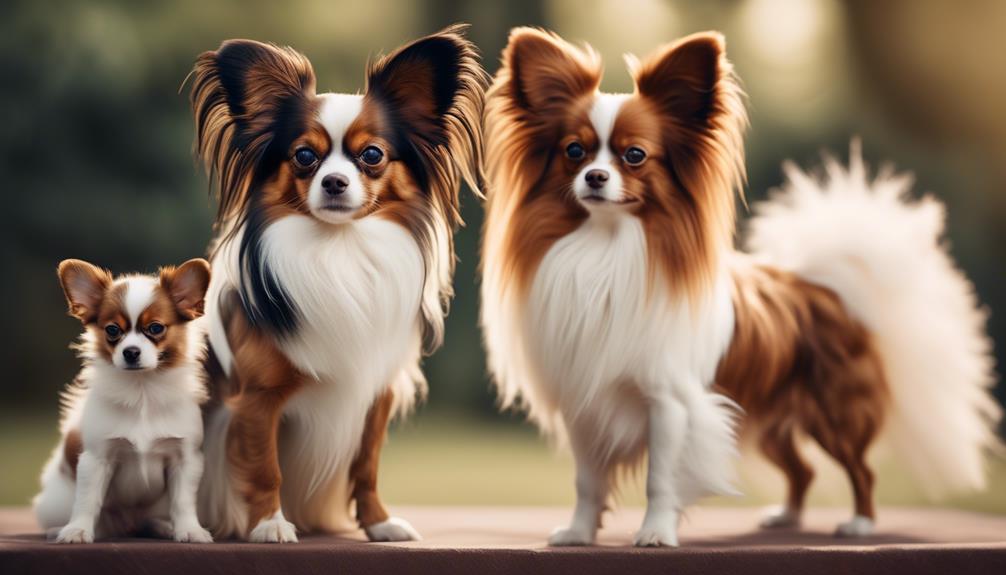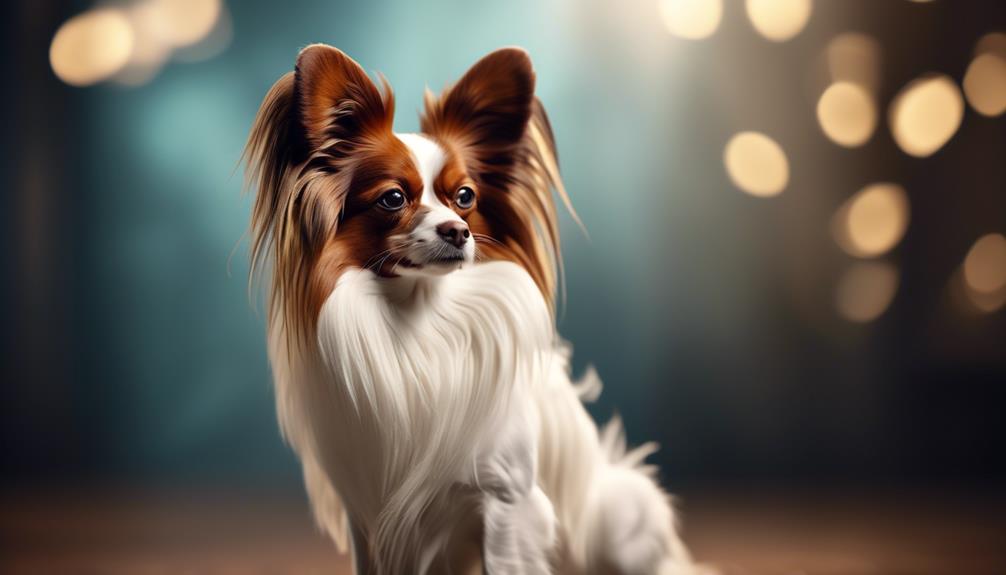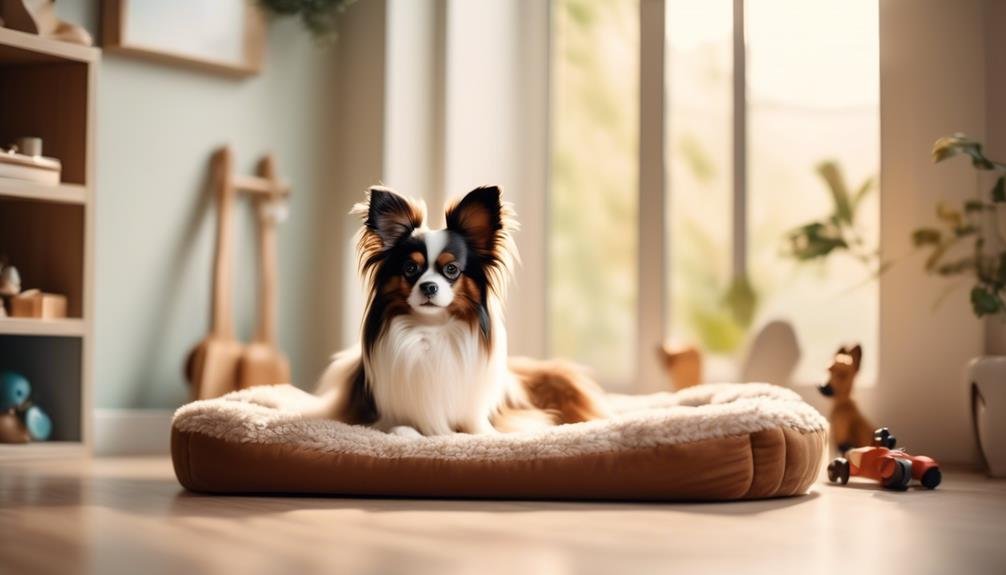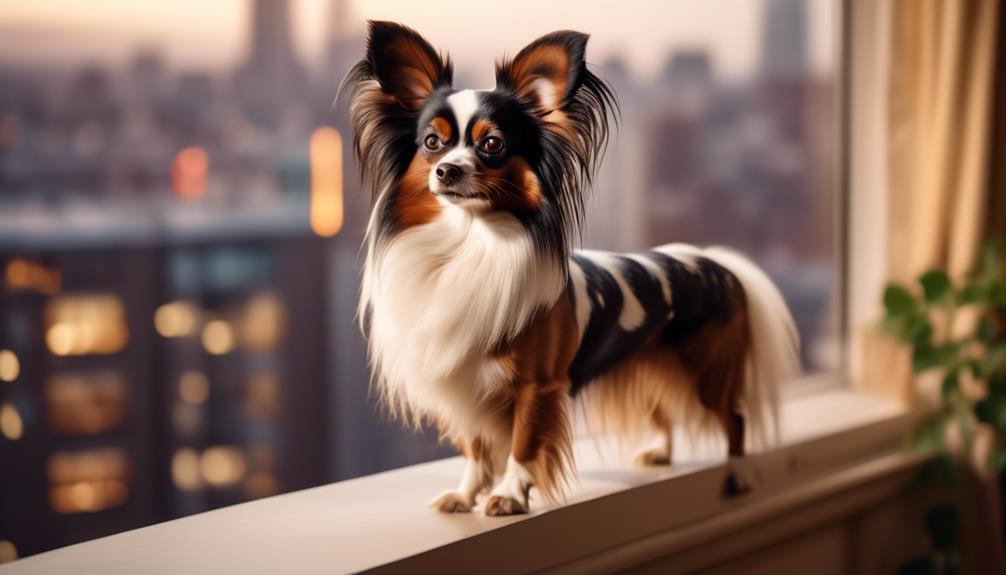With their elegant butterfly-like ears and petite size, the Papillon dog breed exudes both charm and grace. Originating in 16th century France, these small and portable companions have captured the hearts of dog lovers worldwide.
But there is more to the Papillon than just their dainty appearance. This article dives into the depths of their origin, size, coat, and temperament, shedding light on the true essence of this delightful breed.
From their playful and intelligent nature to their adaptability to apartment living, there is a wealth of information to uncover about the Papillon.
So, come along on this journey of discovery and uncover the fascinating characteristics of the Papillon dog breed.
Key Takeaways
- Papillons are small and portable dogs, weighing between 4-8 pounds and standing 8-11 inches tall.
- They are active and playful, enjoying activities like running, fetch, and walks.
- Papillons are intelligent and trainable, eager to please and learn new tricks.
- They are loyal and affectionate, always wanting to be with their owners.
Origin and History
The Papillon dog breed has a fascinating origin and history, dating back to the 16th century in France. Descended from toy breeds and spaniels, the Papillon originated as a favorite companion of court ladies throughout Europe. Portrayed in portraits from the 16th century, these dogs were named Papillon for their resemblance to butterflies, with their large, butterfly-like ears.
They were also known as Epagneul Nain, Dwarf Continental Spaniels, and Little Squirrel Dogs. Interestingly, a drop-eared variety called Phalene still exists within the breed.
The Papillon’s history is rich and varied, making them a beloved breed today. With their small size and charming appearance, they continue to capture the hearts of dog lovers around the world.
Size and Lifespan
Continuing with the discussion on the Papillon dog breed, let’s now explore their size and lifespan. Papillons are a small breed, standing 8-11 inches tall and weighing 4-8 pounds. They have a relatively long lifespan, with an average lifespan of 12-15 years. To give a clearer picture, here is a table summarizing the size and lifespan of Papillons:
| Size |
Lifespan |
| Height: 8-11 inches |
Average: 12-15 years |
| Weight: 4-8 pounds |
|
Papillons may be small in size, but they have a long lifespan, providing many years of companionship to their owners.
Coat and Grooming
Papillons have a beautiful long, silky, and flowing coat that requires regular grooming. Here are three reasons why grooming is important for this breed:
- Maintaining their regal appearance: Regular grooming helps keep the Papillon’s coat looking its best. With their long, flowing hair, regular brushing helps prevent tangles and mats, keeping them looking elegant and well-groomed.
- Preventing skin issues: Regular grooming allows for the thorough inspection of the Papillon’s skin, ensuring that any potential issues, such as dryness, irritation, or rashes, are caught early on. This can help prevent more serious skin problems from developing.
- Bonding time: Grooming sessions can be a great opportunity for bonding between the Papillon and their owner. It provides a chance for physical contact, grooming, and attention, strengthening the bond between the two.
Temperament and Personality
The Papillon breed is known for its happy, outgoing, and intelligent temperament. These dogs are highly social and enjoy being around people and other animals. They are playful and have a moderate to intense activity level, requiring regular exercise and mental stimulation. Papillons are highly trainable and eager to please, making them a good choice for obedience training and learning new tricks. While they are not typically cuddly dogs, they are loyal and affectionate towards their owners. Early socialization is important for Papillons to ensure they develop into well-rounded dogs. Overall, the Papillon’s personality is lively, alert, and friendly, making them a great companion for individuals and families alike.
| Temperament Characteristics |
Personality Traits |
| Happy |
Lively |
| Outgoing |
Alert |
| Intelligent |
Friendly |
| Playful |
|
| Affectionate |
|
Health Concerns
Moving on to the topic of health concerns, it’s important to be aware of potential issues that can affect the well-being of the Papillon breed. Despite their overall good health, there are a few conditions that Papillons may be prone to:
- Patellar Luxation: This is a common problem in small dogs, including Papillons. It occurs when the kneecap slips out of place, causing pain and difficulty in walking.
- Hypoglycemia: Toy breed puppies, including Papillons, are susceptible to low blood sugar levels. It’s important to monitor their diet and provide frequent meals to prevent any drop in sugar levels.
- Collapsed Trachea: This condition affects the airway, making it difficult for the dog to breathe. Papillons may be prone to this due to their small size and delicate trachea.
Being aware of these potential health concerns can help Papillon owners take proactive measures to ensure the well-being of their beloved pets. Regular veterinary check-ups and a healthy lifestyle can contribute to a long and happy life for these charming little dogs.
Care and Housing Needs
To ensure the well-being of a Papillon, it’s important to understand their care and housing needs.
Papillons are housedogs and aren’t suited for living outdoors. They’re active and enjoy having a yard to run in, but they also need daily walks or playtimes to keep them mentally and physically stimulated.
Caution is needed when handling them as they can be fragile and prone to injuries. Despite their small size, Papillons are often described as mountain goats because they can be found on high spots like tables or furniture.
Providing a safe and comfortable living environment, along with regular exercise and mental stimulation, is essential for the overall health and happiness of a Papillon.
Considerations for Apartment Living
Consider factors such as energy levels and behavior towards neighbors when determining if a Papillon is suitable for apartment living. While size isn’t the only factor to consider, it’s important to assess the energy levels of a dog breed before bringing them into a small living space.
Here are some considerations for apartment living with a Papillon:
- Quiet and Low-energy: A Papillon that’s quiet and low-energy will be more likely to adapt well to apartment living. This means less noise disturbance for neighbors and a more peaceful living environment for everyone involved.
- Polite towards Others: It’s important to choose a dog that’s polite towards others, including neighbors. A Papillon that’s well-mannered and respectful of others’ space and privacy will help maintain a harmonious living environment.
- Calm Indoors: A Papillon that’s calm indoors will be better suited for apartment living. A dog that isn’t overly active or prone to destructive behavior will be more content in a smaller space and less likely to cause disturbances.
Frequently Asked Questions
Are Papillons Good With Children and Other Pets?
Papillons are generally good with children and other pets. They have a friendly and outgoing temperament, making them suitable companions. However, as with any dog, proper socialization and supervision are important for a harmonious household.
Do Papillons Require a Lot of Exercise?
Papillons require a moderate amount of exercise to keep them happy and healthy. They enjoy daily walks, playtime, and mental stimulation. Although they are small, they have a good amount of energy to burn.
Are Papillons Easy to Train?
Papillons are generally easy to train. They are intelligent and eager to please, making them responsive to training. Consistency, positive reinforcement, and early socialization are important for a well-trained Papillon.
How Often Should Papillons Be Groomed?
Papillons should be groomed frequently. Regular brushing is necessary to maintain their long, silky coat. Additionally, they may need regular visits to the groomer for trimming and to keep their coat looking its best.
Are Papillons Prone to Separation Anxiety?
Papillons can be prone to separation anxiety. They are known for their loyalty and affection towards their owners, which can result in distress when left alone. Proper training and gradual desensitization can help manage this behavior.
What Are the Similarities and Differences Between Papillon and Hamiltonstovare Dog Breeds?
When it comes to hamiltonstovare dog characteristics information, both Papillon and Hamiltonstovare breeds share a high level of intelligence and agility. However, the main differences lie in their size and appearance. Papillons are small, elegant dogs with distinctive butterfly-shaped ears, while Hamiltonstovare are larger, muscular dogs with a more robust appearance.
Conclusion
In conclusion, the Papillon dog breed is a small and portable companion known for its distinctive butterfly-like ears. They have a happy and outgoing temperament, and are loyal and affectionate towards their owners.
Papillons have a long, silky coat that requires regular grooming. They are generally healthy, but may be prone to certain health concerns.
With proper care and exercise, Papillons can adapt well to apartment living. Overall, the Papillon is a wonderful and playful breed that brings joy to any owner.










